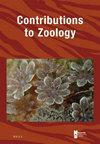坦噶尼喀湖沙丁鱼的单系寄生虫:多样性、起源和种内变异
IF 2.2
2区 生物学
Q1 ZOOLOGY
引用次数: 24
摘要
尽管坦噶尼喀湖的沿岸和底栖区以其多样的鱼类群落而闻名,但其中上层区以少数物种为主,其中两种代表性的斑蝶科(Limnothrisa miodon和Stolothrisa tanganicae)发挥了关键作用。我们调查了感染这些淡水群落的单基因动物群,以探索寄生虫形态与宿主物种身份或季节和地理起源之间的联系,这可能揭示宿主种群结构。此外,我们进行了系统发育分析,以测试这些寄生扁虫是否反映了其宿主物种的海洋起源。基于406个感染385个宿主标本的寄生虫标本,用三个分子标记从形态学上鉴定了两个单基因的Kapentagyrus Kmentová,Gelnar和Vanhove,gen.nov。其中一个种,木齿冠回。nov.是L.miodon的特异性宿主,而其同源物,即科学上新发现的,被描述为唐氏卡彭塔回(Kapentagyrus tanganicanus Kmentová,Gelnar和Vanhove,sp.nov.),正在感染这两个clupeid物种。毒蜥寄生虫硬部的形态计量学表现出特异性内变异,这与寄主物种的身份和季节性有关。坦噶尼喀湖北端和南端的半抗原形态计量学存在显著的特异性差异,这支持了单基因作为宿主群体结构标签的潜在用途。根据系统发育推断,我们认为目前已知的感染非洲蟾蜍的单基因物种的淡水来源,坦噶尼喀湖的两个物种代表了一个截然不同的谱系。本文章由计算机程序翻译,如有差异,请以英文原文为准。
Monogenean parasites of sardines in Lake Tanganyika: diversity, origin and intraspecific variability
Whereas Lake Tanganyika’s littoral and benthic zones are famous for their diverse fish communities, its pelagic zone is dominated by few species, of which two representatives of Clupeidae (Limnothrissa miodon and Stolothrissa tanganicae) take a pivotal role. We investigated the monogenean fauna infecting these freshwater clupeids to explore the link between parasite morphology and host species identity, or seasonal and geographical origin, which may reveal host population structure. Furthermore, we conducted phylogenetic analyses to test whether these parasitic flatworms mirror their host species’ marine origin. Based on 406 parasite specimens infecting 385 host specimens, two monogenean species of Kapentagyrus Kmentová, Gelnar and Vanhove, gen. nov. were morphologically identified and placed in the phylogeny of Dactylogyridae using three molecular markers. One of the species, Kapentagyrus limnotrissae comb. nov., is host-specific to L. miodon while its congener, which is new to science and described as Kapentagyrus tanganicanus Kmentová, Gelnar and Vanhove, sp. nov., is infecting both clupeid species. Morphometrics of the parasites’ hard parts showed intra-specific variability, related to host species identity and seasonality in K. tanganicanus. Significant intra-specific differences in haptor morphometrics between the northern and southern end of Lake Tanganyika were found, and support the potential use of monogeneans as tags for host population structure. Based on phylogenetic inference, we suggest a freshwater origin of the currently known monogenean species infecting clupeids in Africa, with the two species from Lake Tanganyika representing a quite distinct lineage.
求助全文
通过发布文献求助,成功后即可免费获取论文全文。
去求助
来源期刊

Contributions to Zoology
生物-动物学
CiteScore
4.00
自引率
4.50%
发文量
16
审稿时长
>12 weeks
期刊介绍:
Contributions to Zoology solicits high-quality papers in all systematics-related branches of comparative zoology (including paleozoology). Preference will be given to manuscripts dealing with conceptual issues and to integrative papers (e.g., ecology and biodiversity, morphology and phylogeny and character state evolution, phylogeny and historical biogeography, systematics and bioinformatics, bioinformatics and biodiversity, habitat disturbance and biogeography, etc.). Reviews and alpha-taxonomic contributions are considered for publication, but acceptance will depend on their high quality and exceptional nature.
 求助内容:
求助内容: 应助结果提醒方式:
应助结果提醒方式:


